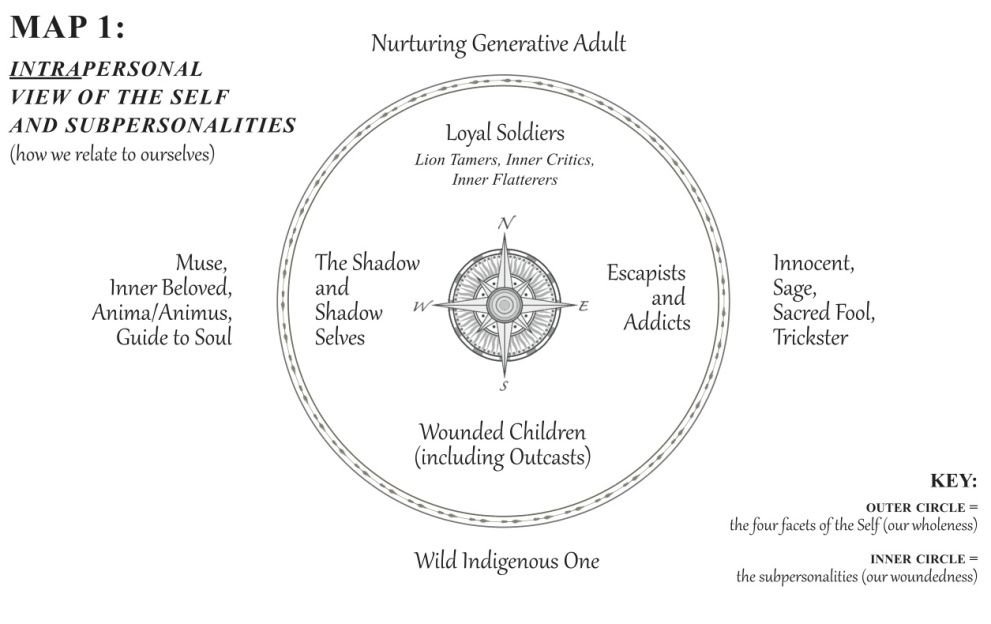Growing up a Boy Scout, I learned early on the value of a good map when it comes to navigating unknown lands. I remember on more than one occasion a leader would hand me a map and say, “This is where we are going.” The first thing I needed to determine? Where we were.
With a good map, a working compass, and a bit of orienteering skill, it is quite possible to figure out where you are and how to get where you want to go. So what map and compass do I use in my reconstruction journey? What tools do I use, not to fix myself, but to understand myself, create space for me to compassionately change my self-perspective, and learn to embody what is most true about me?
Finding My Soul Map
In October of 2019, days before my 45th birthday, I canceled my membership to the Dad Edge Alliance. That is a strange place to begin a conversation about how I found the resource that helps me map out my psyche. But it strikes me as the path most relatable.
The Alliance is a gathering of dads from all over the country who seek to better themselves, and ultimately, that is why I left. Over the previous year and a half I read books, followed tactical guides, engages in accountability groups, and made a couple of appearances on their weekly podcast to share my journey (you can listen here and here).
I am thankful for the men there as it is a place where I began to learn vulnerability and the work forced me to see a world beyond myself. But when all the work I put in failed to resolve the challenges I struggled with, I knew I needed to move on. For a year and a half I focused on doing, but I needed something that would help with my being.
My post-Alliance research led me to Illumen, an organization founded by Jesuit priest Richard Rohr aimed at providing rites of passage for modern men. While the Colorado chapter had little to offer, someone there pointed me to Dan Dolquist and his training with eco-psychologist Bill Plotkin. Plotkin is the creator of the Nature-Based Map of the Human Psyche.

Wounded, Not Broken
Rather than seeing ourselves as broken or fixed, Plotkin’s map invites us to think of ourselves as functioning in woundedness or wholeness. At first, wounded might sound eerily similar to broken. When you cut yourself or pull a muscle you are wounded, but you are not broken. Broken implies something fundamentally wrong with you that needs replacement or repair. But your body (including your soul) has a miraculous capability of healing, you just need to know how to care for it.
Moreover, woundedness links what is wrong not to something in our nature or being, but our experiences. We are not fundamentally flawed, but doing our best to cope with a world that is often unkind. This invites compassion and empathy rather than judgment.
How To Use Plotkin’s Map
Plotkin’s invitation happens in each of the four aspects of the human psyche, with each aspect corresponding to a direction. For example, the South is the direction of the Wild Indigenous One who is “deliriously in love with the natural world in which we are rooted.” This is a direction of trust that we are cared for and holds a deep sense of provision. There is safety and security here. To dwell in this space means to resonate with Jesus’ invitation in Matthew 6:
That is why I tell you not to worry about everyday life—whether you have enough food and drink, or enough clothes to wear. Isn’t life more than food, and your body more than clothing? Look at the birds. They don’t plant or harvest or store food in barns, for your heavenly Father feeds them. And aren’t you far more valuable to him than they are? Can all your worries add a single moment to your life?
But when we operate from woundedness, we are like abandoned children. We do not feel safe or secure, nor do we trust that we are cared for. Instead, we engage in coping mechanisms that seek to fulfill our relational needs. For those familiar with Robert Glover’s, No More Mr. Nice Guy, nice guys are wounded children who believe, if they are nice to a woman, she will fulfill their needs.
Healing the Wounded Child
How do we heal our wounded child? We step in the opposite direction and embrace the nurturing generative adult. By parenting ourselves we can find the security and safety we did not experience at an early age. Here we can nurture trust that brings freedom to explore the world with boldness. Understanding this is why Glover challenges men to intentionally meet their own needs rather than tricking their wife or partner into giving them what they desire.
In this way, Plotkin’s map invites us to see where we are and gives us guidance on how to graciously move from woundedness to wholeness.
Further Exploration
Book: Finding Your Wild by Dan Dolquist
This is an accessible version of Rev. Dr. Dan Dolquit’s dissertation. In it, he provides an accessible examination of Plotkin’s work through a Christian lens.
Book: Wild Mind: A Field Guide to the Human Psyche by Bill Plotkin
Do you want more depth that Dan’s or my introduction? Here is Bill’s in-depth exploration of of the map he created.
What’s Next?
A map alone is limited, so next week we will add the compass of the Enneagram to give us an additional tool to help us discover where we are.